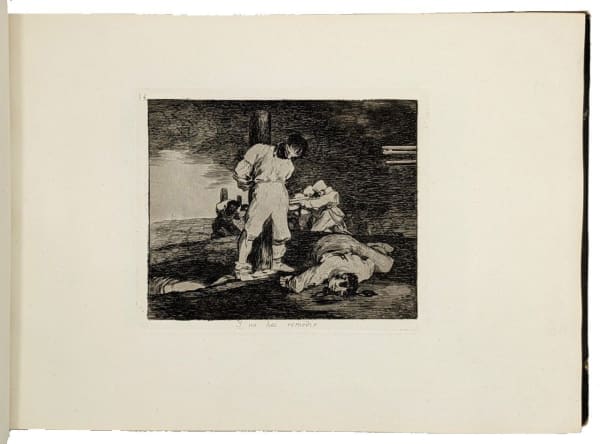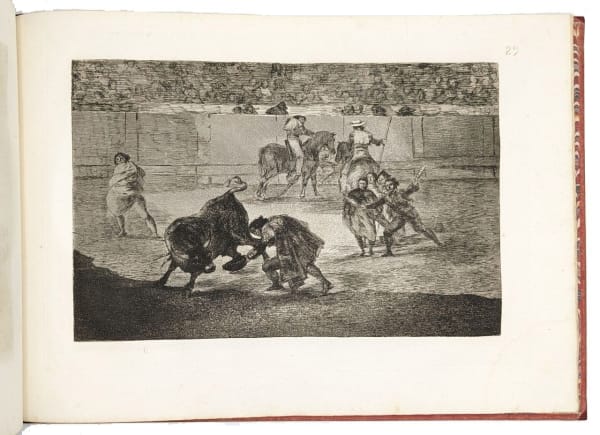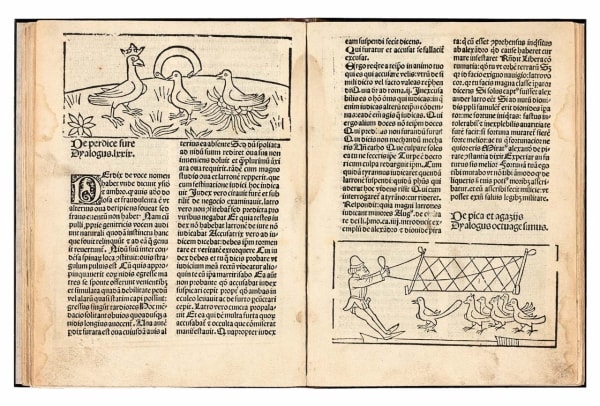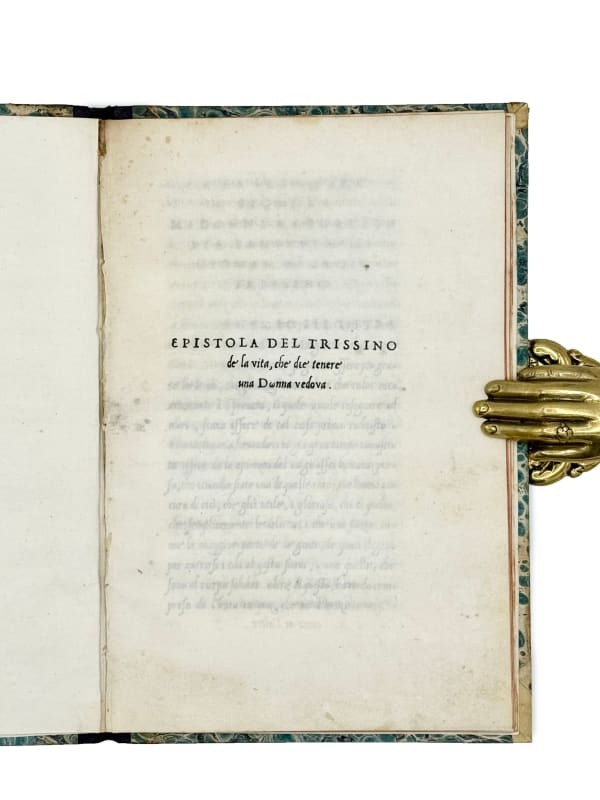-
![[Illustrated incunable Ars Moriendi], Ars moriendi ex varijs scripturarum sententiis collecta/cu(m) figuris ad resistendii in mortis agone dyabolice sugestioni, S.a. [1495/98]. Leipzig. Conrad Kachelofen.](data:image/gif;base64,R0lGODlhAQABAIAAAAAAAP///yH5BAEAAAAALAAAAAABAAEAAAIBRAA7) [Illustrated incunable Ars Moriendi]Ars moriendi ex varijs scripturarum sententiis collecta/cu(m) figuris ad resistendii in mortis agone dyabolice sugestioni, S.a. [1495/98]. Leipzig. Conrad Kachelofen.The Dyson Perrins-Hermann Marx copy of the Ars Moriendi.
[Illustrated incunable Ars Moriendi]Ars moriendi ex varijs scripturarum sententiis collecta/cu(m) figuris ad resistendii in mortis agone dyabolice sugestioni, S.a. [1495/98]. Leipzig. Conrad Kachelofen.The Dyson Perrins-Hermann Marx copy of the Ars Moriendi.
Fascinating illustrated incunable Ars Moriendi, or Art of Dying, with a wonderful and rarely seen striking set of woodcuts, a medieval best seller, and one of the great themes of medieval life, inspired in the woodblock books. As with all early editions, this edition is rare. This is a very fine, nearly uncut copy of the Ars Moriendi, which comes from two of the greatest English libraries of the 20th century. -
![Ulrich Pinder and Geiler von Kaysersberg, Exceptional sammelband of first editions by Ulrich Pinder and Geiler von Kaysersberg, most important illustrated works in the contemporary binding., I. Pinder, Ulrich. Speculum passionis domini nostri Ihesu Christi. 30 August 1507. Nuremberg. [Friedrich Peypus at the author’s press]; II. Geiler von Kaysersberg, Johannes. Passionis Christi unum ex quattuor evangelistis textum (edited by Philesius Ringm](data:image/gif;base64,R0lGODlhAQABAIAAAAAAAP///yH5BAEAAAAALAAAAAABAAEAAAIBRAA7) Ulrich Pinder and Geiler von KaysersbergExceptional sammelband of first editions by Ulrich Pinder and Geiler von Kaysersberg, most important illustrated works in the contemporary binding., I. Pinder, Ulrich. Speculum passionis domini nostri Ihesu Christi. 30 August 1507. Nuremberg. [Friedrich Peypus at the author’s press]; II. Geiler von Kaysersberg, Johannes. Passionis Christi unum ex quattuor evangelistis textum (edited by Philesius RingmGreat woodcut art from the time of Durer: a collection of two splendid illustrated books and a historical work.
Ulrich Pinder and Geiler von KaysersbergExceptional sammelband of first editions by Ulrich Pinder and Geiler von Kaysersberg, most important illustrated works in the contemporary binding., I. Pinder, Ulrich. Speculum passionis domini nostri Ihesu Christi. 30 August 1507. Nuremberg. [Friedrich Peypus at the author’s press]; II. Geiler von Kaysersberg, Johannes. Passionis Christi unum ex quattuor evangelistis textum (edited by Philesius RingmGreat woodcut art from the time of Durer: a collection of two splendid illustrated books and a historical work.
Rare first editions of Pinder and von Kaysersberg’s remarkable illustrated works, along with Coccius Sabellicus’ Hebrew history, all housed in the contemporary binding, and in exceptional condition. -
![Gutenberg, Johann, [Biblia Latina], [ca. 1455]. [Mainz]. [Johann Gutenberg & Johann Fust].](data:image/gif;base64,R0lGODlhAQABAIAAAAAAAP///yH5BAEAAAAALAAAAAABAAEAAAIBRAA7) Gutenberg, Johann[Biblia Latina], [ca. 1455]. [Mainz]. [Johann Gutenberg & Johann Fust].A leaf from the Gutenberg Bible, “in many ways the greatest of all printed books”(PMM 1) – Ordering the second making of the Tablets with the Commandments and the Ark
Gutenberg, Johann[Biblia Latina], [ca. 1455]. [Mainz]. [Johann Gutenberg & Johann Fust].A leaf from the Gutenberg Bible, “in many ways the greatest of all printed books”(PMM 1) – Ordering the second making of the Tablets with the Commandments and the Ark
First edition, a textually significant leaf from the first substantial book printed from movable type in the western world, now known simply as the Gutenberg Bible, or the 42-line Bible: “in many ways the greatest of all printed books” (PMM 1). This leaf is a particularly interesting one, as it contains Deuteronomy IX and most of X, commanding the making of the Tablets after the destruction of the first.
-
![Meynradus von Einsiedeln, Passio Sancti Meynradi martyris et heremite. Ed. Sebastian Brant, Basel. Michael Furter, XII. kal. octobris [= 20 Sept.] 1496.](data:image/gif;base64,R0lGODlhAQABAIAAAAAAAP///yH5BAEAAAAALAAAAAABAAEAAAIBRAA7) Meynradus von EinsiedelnPassio Sancti Meynradi martyris et heremite. Ed. Sebastian Brant, Basel. Michael Furter, XII. kal. octobris [= 20 Sept.] 1496.The legend of the Swiss Saint Meinrad and the foundation of Einsiedeln Abbey.
Meynradus von EinsiedelnPassio Sancti Meynradi martyris et heremite. Ed. Sebastian Brant, Basel. Michael Furter, XII. kal. octobris [= 20 Sept.] 1496.The legend of the Swiss Saint Meinrad and the foundation of Einsiedeln Abbey.
First Latin edition, this small incunable contains the account of the life and martyrdom of St. Meinrad of Einsiedeln, illustrated with 21 fine, large woodcuts. Sebastian Brant's rare Latin edition is based on a 12th century manuscript.
-
 Gessner, ConradHistoriae animalium Liber I (-IV), 1551-1558. Zürich. Christoph Froschauer.Extraordinary copy of the first edition of this “encyclopaedia of contemporary knowledge” (PMM), here with the woodcuts in contemporary color and in uniform contemporary bindings
Gessner, ConradHistoriae animalium Liber I (-IV), 1551-1558. Zürich. Christoph Froschauer.Extraordinary copy of the first edition of this “encyclopaedia of contemporary knowledge” (PMM), here with the woodcuts in contemporary color and in uniform contemporary bindings
First edition, a spectacular set with the woodcut in fine contemporary color and housed in uniform contemporary bindings. Conrad Gesner (1516-1565) was one of the great polymaths of the Renaissance and one of the founders of modern zoology. “His History of Animals is an encyclopaedia of contemporary knowledge, intended to replace not only medieval compilations but even Aristotle's work of the same title... Although the Historia Animalium does not yet show any recognition of a connexion between different forms of living nature and fails to conform to our modern ideas of biological research, it was a great step forward and remained the most authoritative zoological book between Aristotle and the publication of Ray's classification of fauna in 1693” (PMM). -
 Jacobus PubliciusArs oratoria. Ars epistolandi. Ars memorativa, 30 November 1482. Venice. Erhard Ratdolt.The first book with a printed visual alphabet and the first illustration of a chess board
Jacobus PubliciusArs oratoria. Ars epistolandi. Ars memorativa, 30 November 1482. Venice. Erhard Ratdolt.The first book with a printed visual alphabet and the first illustration of a chess board
First edition and first issue of this illustrated epitome of the rhetorical arts, representing the first memory treatise to appear in print, the first book containing a printed visual alphabet and the first work to show a printed illustration of a chess board: this woodcut identifies this copy as the extremely rare first issue of the edition, being printed on l. d8r – blank in the second issue, as in most other surviving copies.
-
![Pseudo-Hieronymus, [Vitas patrum] Der altväter leben., 25 September 1482. Augsburg. Anton Sorg.](data:image/gif;base64,R0lGODlhAQABAIAAAAAAAP///yH5BAEAAAAALAAAAAABAAEAAAIBRAA7) Pseudo-Hieronymus[Vitas patrum] Der altväter leben., 25 September 1482. Augsburg. Anton Sorg.Exceptional early Vitas Patrum, with a set of 275 woodcut illustrations in contemporary color, here used for the time for this work
Pseudo-Hieronymus[Vitas patrum] Der altväter leben., 25 September 1482. Augsburg. Anton Sorg.Exceptional early Vitas Patrum, with a set of 275 woodcut illustrations in contemporary color, here used for the time for this work
The first edition with this illustration cycle, each woodcut in vibrant contemporary coloring, of this influential early work on the lives of the Saints of Christendom; second German edition overall. -
![[Woodblocks for Tarot Cards], Four wooden matrices, carved for woodcut printing, corresponding to a complete tarot of 78 cards, 18th century. Probably Northern Italy.](data:image/gif;base64,R0lGODlhAQABAIAAAAAAAP///yH5BAEAAAAALAAAAAABAAEAAAIBRAA7) [Woodblocks for Tarot Cards]Four wooden matrices, carved for woodcut printing, corresponding to a complete tarot of 78 cards, 18th century. Probably Northern Italy.Exceptional set of 18th century woodblocks for a complete deck of Tarot cards.Reserved
[Woodblocks for Tarot Cards]Four wooden matrices, carved for woodcut printing, corresponding to a complete tarot of 78 cards, 18th century. Probably Northern Italy.Exceptional set of 18th century woodblocks for a complete deck of Tarot cards.Reserved
A remarkable set of the four woodblocks used to print a deck of Tarot Cards, in Italian style, composed of 10 numbered cards (some with their value in Roman numerals) and 4 figures (identified at bottom). The trump cards, 0-21, also have their identification at the bottom (except the one corresponding to the 'death', as usual) and the numbering corresponding to each card at the top, also in Roman numerals (except for the madman, 'Le Fou', considered the precedent of the joker, which is unnumbered). -
 Goya y Lucientes, Francisco deLos Desastres de la Guerra, 1863. Madrid. Real Academia de Nobles Artes de San Fernando.First edition of Goya´s masterful artistic depiction of War, universalizing the theme like never before had been done.
Goya y Lucientes, Francisco deLos Desastres de la Guerra, 1863. Madrid. Real Academia de Nobles Artes de San Fernando.First edition of Goya´s masterful artistic depiction of War, universalizing the theme like never before had been done.
The first edition of Goya's impassioned 'Disasters of War', one of the most visually arresting artistic creations of all times, which has forever influenced our perception of war, the grief, the pain, the madness, our civilization at its most gruesome, universalizing the theme of war like never before, often represented in movies when an iconographic rendering of humanity at its lowest can come to, at the same time, as remarkable artistic achievement by one of the world´s most famous, influential, and wonderful artists of all times. -
 Goya y Lucientes, Francisco deLa Tauromaquia, 1816. Madrid.First edition of Goya´s magnificent Tauromaquia, with a marvelous provenance.
Goya y Lucientes, Francisco deLa Tauromaquia, 1816. Madrid.First edition of Goya´s magnificent Tauromaquia, with a marvelous provenance.
First edition, the rarest of Goya's suites of plates, created between 1814 and 1816 and focusing on the drama involved in bullfighting, and a noteworthy copy, owned by one of the most important figures of the art world of Spain of the first half of the 19th century and one of the first Goya admirers, Valentin Carderera, who here presents it as a gift to another relevant figure of Europe´s cultural world, Theophile Gautier, one of Goya's first admirers in France.
-
![Goya y Lucientes, Francisco de, Los Caprichos, 1799. S.l. [Madrid]. Printed by the artist.](data:image/gif;base64,R0lGODlhAQABAIAAAAAAAP///yH5BAEAAAAALAAAAAABAAEAAAIBRAA7) Goya y Lucientes, Francisco deLos Caprichos, 1799. S.l. [Madrid]. Printed by the artist.Magnificent copy with early impressions of the first edition of Goya´s masterpiece, in a contemporary binding.
Goya y Lucientes, Francisco deLos Caprichos, 1799. S.l. [Madrid]. Printed by the artist.Magnificent copy with early impressions of the first edition of Goya´s masterpiece, in a contemporary binding.
A superb set of the first edition of Goya's greatest series of engravings, an early copy printed shortly after the scratch occurred to engraving 45, bound in contemporary Spanish calf and with excellent impressions of the prints. From the edition limited to approximately 300 copies (see Harris).
-
![[Conti, Francesco Bartolomeo, Francesco Mancini & John Jacob Heidegger], Operas of Clotilda, Hydaspes and Almahide [title from binding]: Songs in the New Opera, Call'd Clotilda [with:] Songs in the New Opera Call'd Hydaspes [and:] Songs in the New Opera Call'd Almahide. The Songs done in Italian & English as they are Perform'd, 1709, 1710, 1710. London. Printed for & Sold by John Walsh, P. Randall, and I. Hare.](data:image/gif;base64,R0lGODlhAQABAIAAAAAAAP///yH5BAEAAAAALAAAAAABAAEAAAIBRAA7) [Conti, Francesco Bartolomeo, Francesco Mancini & John Jacob Heidegger]Operas of Clotilda, Hydaspes and Almahide [title from binding]: Songs in the New Opera, Call'd Clotilda [with:] Songs in the New Opera Call'd Hydaspes [and:] Songs in the New Opera Call'd Almahide. The Songs done in Italian & English as they are Perform'd, 1709, 1710, 1710. London. Printed for & Sold by John Walsh, P. Randall, and I. Hare.First editions of three early works of the Italian Opera in England in a contemporary English binding
[Conti, Francesco Bartolomeo, Francesco Mancini & John Jacob Heidegger]Operas of Clotilda, Hydaspes and Almahide [title from binding]: Songs in the New Opera, Call'd Clotilda [with:] Songs in the New Opera Call'd Hydaspes [and:] Songs in the New Opera Call'd Almahide. The Songs done in Italian & English as they are Perform'd, 1709, 1710, 1710. London. Printed for & Sold by John Walsh, P. Randall, and I. Hare.First editions of three early works of the Italian Opera in England in a contemporary English binding
A beautiful sammelband of first editions of three early works of the Italian Opera in England, including the first and second – 'Almahide' and 'Hydaspes' – sung entirely in Italian, all first performed at Sir John Vanbrugh's Queen's Theatre in the Haymarket during the reign of Queen Anne.
-
 Bergame, Nicolas de; AesopDyalogus Creaturarum Moralisatus, 11 April 1491. Antwerp. Gerard Leeu.Illustrated incunable Fable Book, with a fascinating contemporary English provenance.
Bergame, Nicolas de; AesopDyalogus Creaturarum Moralisatus, 11 April 1491. Antwerp. Gerard Leeu.Illustrated incunable Fable Book, with a fascinating contemporary English provenance.
Early illustrated fable-book with 121 popular fables in prose—some of which derive from Aesop—each accompanied by 121 woodcuts from 119 blocks; bound in is a recipe written in English from the second half of the 15th century. “One of the most disarming of early printed books” (Yale, University Gazette, 1968). First published in 1480 in Gouda, birthplace of Gerard Leeu (c.1450–1492), regarded as the most important printer of the Pays Bas and friends with Erasmus; the work was again printed by him, here already in its fifth edition (after those of Cologne, Stockholm, Lyon).
-
 Miro, Joan; Assis, Saint FrancisCantic del Sol, 1975. Barcelona. Gustau Gili.Remarkable work by Miro in the original binding.
Miro, Joan; Assis, Saint FrancisCantic del Sol, 1975. Barcelona. Gustau Gili.Remarkable work by Miro in the original binding.
Remarkable illustrated work by Miro, number 105 from 220, signed Miro in pencil, with the complete suite of 33 original color etching (in and hors-text) for the ´Canticle of the Sun´ by Saint Francis of Assisi, in excellent condition. The Cantic del Sol, or song to the Sun is an admired production by Miro.
-
 Trissino, Giovan GiorgioEpistola del Trissino de la vita, che dee tenere una donna vedova, 1524. Rome. Lodovico vicentino and Lautitio.Humanist Renaissance advice for widows on how to behave
Trissino, Giovan GiorgioEpistola del Trissino de la vita, che dee tenere una donna vedova, 1524. Rome. Lodovico vicentino and Lautitio.Humanist Renaissance advice for widows on how to behave
Extremely rare first edition of this brief pedagogical treatise written in epistolary form, addressed to noblewoman Margherita Pio Sanseverino, offering an intellectual humanist perspective over the strict rules on female behavior dictated by Savonarola. Printed with the beautiful chancery Italic types by Trissino, which brought forward his ideas on the orthography of the Italian language proposing a reform with new characters inspired by phonetic principles.
-
 Niger, Petrus (Peter Schwartz)Tractatus contra perfidos Judeos, 6 June 1475. Esslingen, Konrad Fyner.The first Hebrew characters printed in Germany
Niger, Petrus (Peter Schwartz)Tractatus contra perfidos Judeos, 6 June 1475. Esslingen, Konrad Fyner.The first Hebrew characters printed in Germany
First edition of the “Treatise against the treacherous Jews”, the most infamous among the earliest anti-Jewish polemics, but also the first Hebrew grammar to appear in Germany and the “the first attempt to use Hebrew characters in a Latin incunabulum” (Gordin, 322). Of the utmost rarity, not seen on the market since 1928.
![[Illustrated incunable Ars Moriendi], Ars moriendi ex varijs scripturarum sententiis collecta/cu(m) figuris ad resistendii in mortis agone dyabolice sugestioni, S.a. [1495/98]. Leipzig. Conrad Kachelofen.](https://artlogic-res.cloudinary.com/w_600,c_limit,f_auto,fl_lossy,q_auto/artlogicstorage/hsrarebooks/images/view/185040dcc178b0344d61c55831d2daf2j/hsrarebooks-illustrated-incunable-ars-moriendi-ars-moriendi-ex-varijs-scripturarum-sententiis-collecta-cu-m-figuris-ad-resistendii-in-mortis-agone-dyabolice-sugestioni-s.a.-1495-98.jpg)
![Ulrich Pinder and Geiler von Kaysersberg, Exceptional sammelband of first editions by Ulrich Pinder and Geiler von Kaysersberg, most important illustrated works in the contemporary binding., I. Pinder, Ulrich. Speculum passionis domini nostri Ihesu Christi. 30 August 1507. Nuremberg. [Friedrich Peypus at the author’s press]; II. Geiler von Kaysersberg, Johannes. Passionis Christi unum ex quattuor evangelistis textum (edited by Philesius Ringm](https://artlogic-res.cloudinary.com/w_600,c_limit,f_auto,fl_lossy,q_auto/artlogicstorage/hsrarebooks/images/view/66a25c2dc33e22adf9cb18ba741978edj/hsrarebooks-ulrich-pinder-and-geiler-von-kaysersberg-exceptional-sammelband-of-first-editions-by-ulrich-pinder-and-geiler-von-kaysersberg-most-important-illustrated-works-in-the-co.jpg)
![Gutenberg, Johann, [Biblia Latina], [ca. 1455]. [Mainz]. [Johann Gutenberg & Johann Fust].](https://artlogic-res.cloudinary.com/w_600,c_limit,f_auto,fl_lossy,q_auto/artlogicstorage/hsrarebooks/images/view/e8c2819fcf3bbbd9cf47c4a8acdeb940j/hsrarebooks-gutenberg-johann-biblia-latina-ca.-1455-.-mainz-.-johann-gutenberg-johann-fust-..jpg)
![Meynradus von Einsiedeln, Passio Sancti Meynradi martyris et heremite. Ed. Sebastian Brant, Basel. Michael Furter, XII. kal. octobris [= 20 Sept.] 1496.](https://artlogic-res.cloudinary.com/w_600,c_limit,f_auto,fl_lossy,q_auto/artlogicstorage/hsrarebooks/images/view/7a0a3ec58d2072a63b73254cd5ee1d06j/hsrarebooks-meynradus-von-einsiedeln-passio-sancti-meynradi-martyris-et-heremite.-ed.-sebastian-brant-basel.-michael-furter-xii.-kal.-octobris-20-sept.-1496..jpg)


![Pseudo-Hieronymus, [Vitas patrum] Der altväter leben., 25 September 1482. Augsburg. Anton Sorg.](https://artlogic-res.cloudinary.com/w_600,c_limit,f_auto,fl_lossy,q_auto/artlogicstorage/hsrarebooks/images/view/dc6f5dde777320dd6270bfe56551624bj/hsrarebooks-pseudo-hieronymus-vitas-patrum-der-altva-ter-leben.-25-september-1482.-augsburg.-anton-sorg..jpg)
![[Woodblocks for Tarot Cards], Four wooden matrices, carved for woodcut printing, corresponding to a complete tarot of 78 cards, 18th century. Probably Northern Italy.](https://artlogic-res.cloudinary.com/w_600,c_limit,f_auto,fl_lossy,q_auto/artlogicstorage/hsrarebooks/images/view/4b172fcec71f5ae64278e111ae30a030j/hsrarebooks-woodblocks-for-tarot-cards-four-wooden-matrices-carved-for-woodcut-printing-corresponding-to-a-complete-tarot-of-78-cards-18th-century.-probably-northern-italy..jpg)


![Goya y Lucientes, Francisco de, Los Caprichos, 1799. S.l. [Madrid]. Printed by the artist.](https://artlogic-res.cloudinary.com/w_600,c_limit,f_auto,fl_lossy,q_auto/artlogicstorage/hsrarebooks/images/view/d745bce6ae2b4bad7d61e4ddf2f12bacj/hsrarebooks-goya-y-lucientes-francisco-de-los-caprichos-1799.-s.l.-madrid-.-printed-by-the-artist..jpg)
![[Conti, Francesco Bartolomeo, Francesco Mancini & John Jacob Heidegger], Operas of Clotilda, Hydaspes and Almahide [title from binding]: Songs in the New Opera, Call'd Clotilda [with:] Songs in the New Opera Call'd Hydaspes [and:] Songs in the New Opera Call'd Almahide. The Songs done in Italian & English as they are Perform'd, 1709, 1710, 1710. London. Printed for & Sold by John Walsh, P. Randall, and I. Hare.](https://artlogic-res.cloudinary.com/w_600,c_limit,f_auto,fl_lossy,q_auto/artlogicstorage/hsrarebooks/images/view/2282c616e94e08d17033fcbab96723a5j/hsrarebooks-conti-francesco-bartolomeo-francesco-mancini-john-jacob-heidegger-operas-of-clotilda-hydaspes-and-almahide-title-from-binding-songs-in-the-new-opera-call-d-clotilda-wit.jpg)



